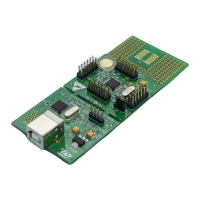Universal asynchronous receiver transmitter (UART) RM0016
334/449 Doc ID 14587 Rev 8
LIN break and delimiter detection
The UART features a break detection circuit which is totally independent from the normal
UART receiver. A break can be detected whenever it occurs, during idle state or during a
frame.
When the receiver is enabled (REN=1 in UART_CR2), the circuit looks at the UART_RX
input for a start signal. The method for detecting start bits is the same when searching break
characters or data. After a start bit has been detected, the circuit samples the next bits
exactly like for the data (on the 8th, 9th and 10th samples). If 10 bits (when the LBDL = 0 in
UART_CR4) or 11 bits (when LBDL=1 in UART_CR4) are detected as ‘0’, and are followed
by a delimiter character, the LBDF flag is set in UART_CR4. If the LBDIEN bit=1, an
interrupt is generated.
If a ‘1’ is sampled before the 10 or 11 have occurred, the break detection circuit cancels the
current detection and searches for a start bit again. If LIN mode is disabled (LINEN=0), the
receiver continues working as a normal UART, without taking into account the break
detection.
If LIN mode is enabled (LINEN=1), as soon as a framing error occurs (i.e. stop bit detected
at ‘0’, which will be the case for any break frame), the receiver stops until the break detection
circuit receives either a ‘1’, if the break word was not complete, or a delimiter character if a
break has been detected.
The behavior of the break detector state machine and the break flag is shown in Figure 129:
Break detection in LIN mode (11-bit break length - LBDL bit is set) on page 335.
The LBDF flag is used in master mode, in slave mode the LHDF flag is used instead.
Examples of break frames are given on Figure 130: Break detection in LIN mode vs framing
error detection on page 336.

